| 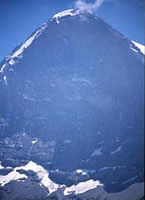 I had thought of the Eiger as a painting subject for quite a while- since being sent a postcard of the Nordwand from a friend who was climbing the Mittelegi Ridge in the early 1990’s. The card is still on my wall and it shows the Face criss-crossed with routes picked out in different colours and styles of dotted line. This sort of image is usually confined to climbing guides, but here it is the climbing routes (the 1938 one in particular) that are important to the popular myth of the mountain. My original idea was for a painting involving the extraordinary tangle of thick multi-coloured lines that mesh with the black & white of the rock and ice of the crag image. I was going to make the routes and the crag as real as each other, mediated by the paint. I never did that, but it remained in my mind that the Eiger has a special status as a public climbing arena, like the colosseum. I had thought of the Eiger as a painting subject for quite a while- since being sent a postcard of the Nordwand from a friend who was climbing the Mittelegi Ridge in the early 1990’s. The card is still on my wall and it shows the Face criss-crossed with routes picked out in different colours and styles of dotted line. This sort of image is usually confined to climbing guides, but here it is the climbing routes (the 1938 one in particular) that are important to the popular myth of the mountain. My original idea was for a painting involving the extraordinary tangle of thick multi-coloured lines that mesh with the black & white of the rock and ice of the crag image. I was going to make the routes and the crag as real as each other, mediated by the paint. I never did that, but it remained in my mind that the Eiger has a special status as a public climbing arena, like the colosseum.
After making a series of paintings a few years ago from the north side of Kanchenjunga , which emphasised the rare untouchability of parts of the earth, valuing the human absence, I was interested to try and make some paintings that dealt with both mountain form and human presence simultaneously. The Eiger seemed just right for this, and so in another vein did Honister Crag quarry, a 300 year old vertical industrial site in the Lake District (another north face), the subject of a parallel series of 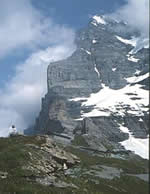 paintings that are in progress. paintings that are in progress.
Stepping off the train at Kleine Scheidegg in July
2003 I was struck by how huge the Eiger Nordwand is, and in the heat of the summer how little snow and ice remained, obscured by dirt and hardly visible against the dark limestone. I’d been re-reading “The White Spider”, and Kasparek’s account of the 1938 ascent, and also Daniel Anker’s comprehensive book about the Eiger “The Vertical Arena”, so the famous features of the crag were big in my mind, but the reality appeared shockingly blank, vast, and difficult to grasp.
Part of the Eiger myth is of course the Hotel Terrace and the telescope through which tourists have viewed the various disasters and rescues on the Face. So I hoped to be able to stay at the belle epoque Hotel Bellevue des Alpes on the col but didn’t know whether it was open or if I could afford it.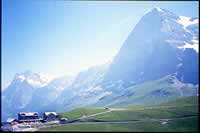 It was open and seemed quite reasonable for Switzerland, particularly as it included a four course dinner. So I had the lonely but peculiarly grand experience of dining on my own for 10 nights , observing the few other guests in the splendid chandeliered dining room with its views of the North Face through the window. When on a painting trip I’m used to existing in a limbo between local people and normal tourists, belonging to
neither. It was open and seemed quite reasonable for Switzerland, particularly as it included a four course dinner. So I had the lonely but peculiarly grand experience of dining on my own for 10 nights , observing the few other guests in the splendid chandeliered dining room with its views of the North Face through the window. When on a painting trip I’m used to existing in a limbo between local people and normal tourists, belonging to
neither.
Making some paintings from life was part of the plan, so I had prepared some small canvases (20x15ins) by priming them with earth colour and had brought water-soluble oil paints with me. I pinned the canvas to a drawing board when painting. A short uphill walk from the hotel with a heavy sac full of painting and photo equipment on the first morning brought me to a point on the lower flanks of the 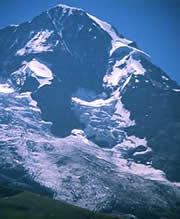 Lauberhorn looking across at the Eiger , Monch, and Jungfrau. The Monch looked so vivid there glittering in front of me that I started straight in with a painting of that, delighting in building up the mountain with strokes of thin, and then thicker white, shadowing it with blue-grey paint, leaving the earthy ground-colour to represent the striped bands of rock, then working darker into that as well. When it’s going well, the physical act of painting moves at the same pace as the thinking process, and the subject is being figured out mentally and physically at the same time, this is very satisfying, but it doesn’t always happen. Often it’s a grinding struggle to get it right. I suspect that the old limbic part of the brain is involved here, going beyond the purely visual. Lauberhorn looking across at the Eiger , Monch, and Jungfrau. The Monch looked so vivid there glittering in front of me that I started straight in with a painting of that, delighting in building up the mountain with strokes of thin, and then thicker white, shadowing it with blue-grey paint, leaving the earthy ground-colour to represent the striped bands of rock, then working darker into that as well. When it’s going well, the physical act of painting moves at the same pace as the thinking process, and the subject is being figured out mentally and physically at the same time, this is very satisfying, but it doesn’t always happen. Often it’s a grinding struggle to get it right. I suspect that the old limbic part of the brain is involved here, going beyond the purely visual.
Over the next ten days I gradually moved the painting site further up the slopes of the Lauberhorn, eventually completing 7 canvases, and thankfully getting out of earshot of the Alpenhorn down at the station. After the Monch painting, I had turned to the Jungfrau with its elegant glaciers and ridges, and then the beautiful Silberhorn, shimmering 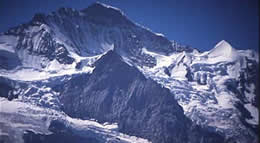 away in the light. These resolved into studies of the various ways ice and rock conjoin, and a reminder when spending hours in front of a mountain of how much movement there is, with the constant calving of the ice. Then three Eiger paintings followed, seen from different angles, getting as straight on as I could for the last one, at a point near Mannlichen. At this range the Eiger was just a dark, triangular, concave hulk looming against the light, but with a tremendous power and presence. away in the light. These resolved into studies of the various ways ice and rock conjoin, and a reminder when spending hours in front of a mountain of how much movement there is, with the constant calving of the ice. Then three Eiger paintings followed, seen from different angles, getting as straight on as I could for the last one, at a point near Mannlichen. At this range the Eiger was just a dark, triangular, concave hulk looming against the light, but with a tremendous power and presence.
I would paint for about four hours in the morning, until the sun moved round too much to be viable, and then spend all afternoon moving across to other vantage points to look at the Eigerwand in detail through binoculars and a telephoto lens, in order to image and imagine various possible configurations for the larger studio paintings.
My intention was to make a series of paintings back in England from these photos, breaking the Face up into self-sufficient sections with their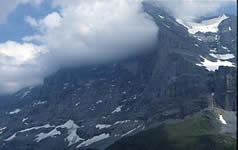 own formal integrity and spacial logic, but together forming a greater narrative of ascent and fall. Most afternoons a stationary cloud formed over the top half of the Face, and I would wait for it to clear sometimes around 4pm. other times not until 5 o’clock. At the lower edge of the cloud that usually hovered half way up the Rote Fluh there was an interesting mix of deep shadow and veiled, dappled sunlight with old snow patches sitting among complex rock terraces, just
right for the paintings I was imagining. own formal integrity and spacial logic, but together forming a greater narrative of ascent and fall. Most afternoons a stationary cloud formed over the top half of the Face, and I would wait for it to clear sometimes around 4pm. other times not until 5 o’clock. At the lower edge of the cloud that usually hovered half way up the Rote Fluh there was an interesting mix of deep shadow and veiled, dappled sunlight with old snow patches sitting among complex rock terraces, just
right for the paintings I was imagining.
I spent a lot of time those afternoons just looking at the Eiger through the binoculars or camera lens, wandering in a detached, disembodied way over the Face, imagining possible paintings out of particular combinations of features.
I soon realised that I wouldn’t be able to see any climbers who may be up there, so forgot about that and concentrated on the form of the rock itself. Although formal qualities came first, I tended to favour the landmarks I recognised, particularly from the 1938 route, this was helped by the fact that their names are so evocative, Death Bivouac, The Ramp, Traverse of the Gods, The Spider and so on. I felt there was something melancholic about the dark, 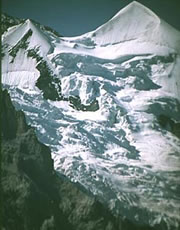 drained, quality of Eiger limestone, but with beautifully complex shapes, where tile-like stratification meets cleaved vertical intervals, for instance where the Hinterstoisser Traverse meets the vertical slice of the Rotefluh, or the filigree of grooves catching the light leading up and out from the Spider. Waiting for the light became obsessional. As it came round onto the Face in the late afternoon it would first hit any ridges and projections and then rake across wall sections, showing the finer textures of the rock. There was a certain optimal time when the distribution of light and shadow was just right, the ratio of about sixty percent shadow to forty percent light seemed best, after which it flattened out in the full evening sunlight. drained, quality of Eiger limestone, but with beautifully complex shapes, where tile-like stratification meets cleaved vertical intervals, for instance where the Hinterstoisser Traverse meets the vertical slice of the Rotefluh, or the filigree of grooves catching the light leading up and out from the Spider. Waiting for the light became obsessional. As it came round onto the Face in the late afternoon it would first hit any ridges and projections and then rake across wall sections, showing the finer textures of the rock. There was a certain optimal time when the distribution of light and shadow was just right, the ratio of about sixty percent shadow to forty percent light seemed best, after which it flattened out in the full evening sunlight.
Because of the unusual heat of last summer everything seemed to be collapsing and melting at an accelerating rate, people were telling me it was the hottest in their memory, and there were stories of massive rockfalls on the Matterhorn and Dent du Geant , and inevitably talk of global warming. So I left Grindlewald with an extra layer of meaning to think about, a tragic one; a possible grand metaphor about humanity eroding its own natural support system, the fragility of the permafrost that holds mountains together.
So far, as I write in March 2004, six studio paintings are completed or nearly so, one of which is 10ft 6ins high of the Exit Grooves with the Spider at the bottom of the picture and part of the summit ridge at the top, creating a tension between downwards drag and upward push, horizontally divided between advancing light and receding shadow.
Another smaller painting Hinterstoisser Traverse deals with the complex of terraces interspersed with snow as they meet the Rote Fluh at the lower fringes of the afternoon cloud. There are also several more studies of The Spider and the 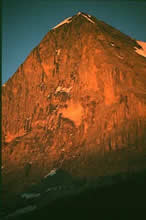 Exit Grooves ranging from 12ins to 7ft. high. Exit Grooves ranging from 12ins to 7ft. high.
Next on the agenda as I write is a painting of the area around the base of the Eiger, which I explored on a dull day in order to at least touch the Eiger rock.
A thunderstorm came over when I was there, and the crag quickly became a collection of waterfalls with impressive rumblings of falling rock so I left the area quickly, dodging lightning on the way back.
The significance of the base of the crag is that it’s both the place where everything ends up, and also where people start to climb. I became interested in the shapes of large patches of hard snow around the base oozing meltwater and streaked with fallen debris, defined by, and in turn helping to define the surrounding rock and scree making a gestalt of positive and negative shapes.
The further into these Eiger paintings I get, the more abstract, and analogous to music they seem, with endless fugues and counterpoints emerging out of the layering of rock, snow and sunlight, and the twin narratives of ascension and fall, human and earthly, underlying it.
Julian Cooper, March 2004
photographs by Julian Cooper
View the Exhibition |